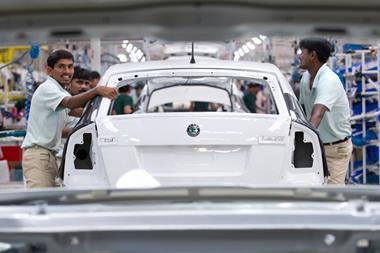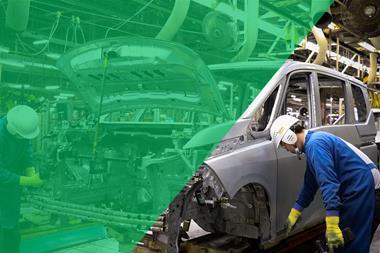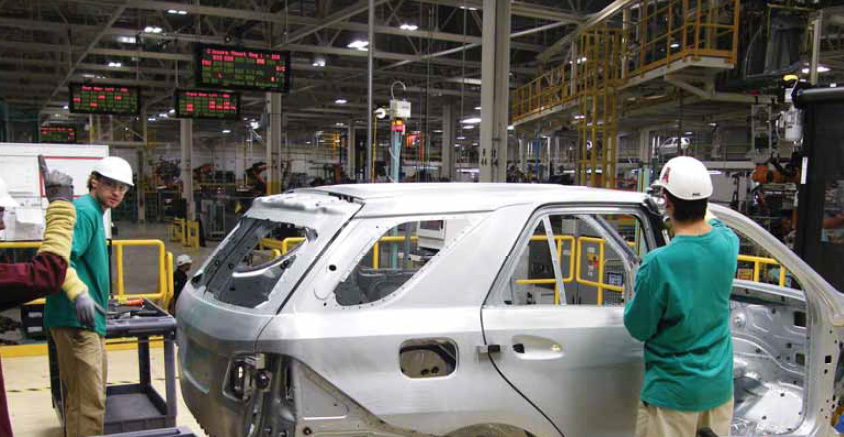
A tour of the bodyshop at the Mercedes-Benz plant in Tuscaloosa, Alabama, which review the technologies that have been added for production of the new M-Class SUV.
In 1997, the M-Class SUV was the first model to enter production at the $400m Mercedes-Benz US International (MBUSI) plant in Tuscaloosa, Alabama. Since then, the R-Class and GL-Class models have been added to production, supported by a further $600m investment to expand the plant’s production capacity, which included adding both a second paintshop and an additional assembly hall.
 For the introduction of the third-generation M-Class, which entered production in September 2010, the bodyshop at MBUSI underwent a major round of updates as part of a $2.4 billion package of investment that will also underwrite future production of the next-generation C-Class saloon, scheduled to start in 2014. On a visit to the plant in September last year, Norbert Wagner, Senior Manager for Series Planning, offered a round-up of how BIW production is arranged at Tuscaloosa, highlighting the new technologies and processes that have been added in order to improve finished vehicle quality.
For the introduction of the third-generation M-Class, which entered production in September 2010, the bodyshop at MBUSI underwent a major round of updates as part of a $2.4 billion package of investment that will also underwrite future production of the next-generation C-Class saloon, scheduled to start in 2014. On a visit to the plant in September last year, Norbert Wagner, Senior Manager for Series Planning, offered a round-up of how BIW production is arranged at Tuscaloosa, highlighting the new technologies and processes that have been added in order to improve finished vehicle quality.
“We have three big areas in the bodyshop,” says Wagner. “We have the Z1 underbody, Z2 sidewall and framing. The Z3 area is for adding ‘hang on’ parts, doors, hoods, tailgates and other closures. Z1 is a carryover from the previous M-Class, but updated to comply with many new legal requirements covering crash testing. For Z2 and Z3, everything is new.”
He goes on to explain that the Z2 and Z3 areas are set up around one major line that is fed using the ‘fishbone’ principle, where parts are fed to the line for addition to the left- and right-hand sides of the car, which is similar to the system used to deliver large bodyside components to the framing areas. This has made the line ultimately flexible - where some lines would not be able to support single-model production due to part delivery issues and conflicting cell takt times, this line can, which means it can produce a single model for as long as is required. “In some areas a team member can load more than 100 individual parts, enough for half a shift, and then go on to do something else. This is an example of low-cost automation, which we’re using for the first time here at MBUSI. The installation was not low cost, but it helps optimize efficiency and it gives us a good return on investment,” says Wagner.
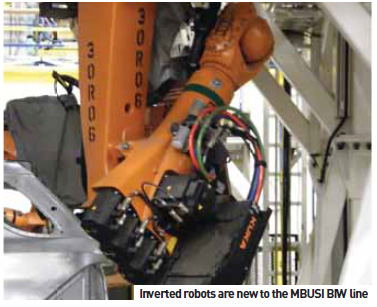 He points out that the first framing cell, which applies the sidewall inners to the underbody, is a standard machine across Mercedes production plants, with some subtle differences. “The size is a little different, between the A-Class and the M-Class for example, but overall it’s the same machine. There’s one frame for the M-Class and one for the GL, indexing (locating) as needed so that the welds can be completed.” When in action, the system reads which model will next enter the cell and the correct gate (or frame) slides in to receive the corresponding part.
He points out that the first framing cell, which applies the sidewall inners to the underbody, is a standard machine across Mercedes production plants, with some subtle differences. “The size is a little different, between the A-Class and the M-Class for example, but overall it’s the same machine. There’s one frame for the M-Class and one for the GL, indexing (locating) as needed so that the welds can be completed.” When in action, the system reads which model will next enter the cell and the correct gate (or frame) slides in to receive the corresponding part.
In this section of the body construction process, Wagner says it is “just a normal bodyshop”, complete with traditional floor-mounted robotics. Further down the line, where the sidewall outer panels are added, these robots are notable by their absence, replaced by equivalent inverted machines. “These are really new and they give you clear floorspace. If you have to repair something the robots are not in the way. They’re fairly easy to replace, I can exchange one in 20 minutes using just a forklift. In fact, it’s easier to take one of these out than a floor model.”
The inverted robots are attached to a fixed steel frame. As Wagner explains, the company was fortunate in that when the frame was being constructed, steel prices were considerably lower than they are now, but the installation helps to address other issues. “Conveyors are usually trussmounted onto the roof, but this is a really light building with no truss reinforcements. With this [line] structure, you can use the second floor to run conveyors, which itself avoids considerable expense. It took a lot of steel to build the line, but it would have taken a lot to reinforce the building.” In addition to carrying the robots for the bodyside outer framing station and related respot cells, the structure also creates a ‘balcony’ buffer area where parts can be stored before being delivered to the line. Additionally, the controller boxes for the robots and weld applications are also ‘upstairs’, which helps to improve lineside access. With the new installation, the only elements remaining on the floor are the main operation panels and teach panels for the robots. “Because the controllers are now on the balcony, there are cables between the two installations. We will consider making the next generation a wireless installation. This [existing installation] was supplied by Comau (part of the Fiat Group), and I’ve heard that Fiat is now using wireless technology at their plants. Now we have a teach panel for every robot; the new design has a switchable system that allows you to select the robot you’re controlling. It’s more expensive, but it’s efficient.” For the present, Wagner is resigned to keeping the current equipment, as he says the existing installation should last at least six years.
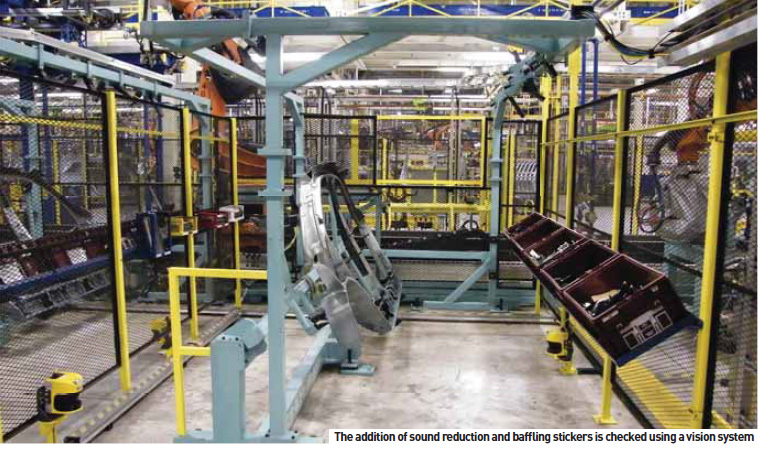
Pleased to meet you
A key part of the process which ultimately delivers parts to the outer panel framing cell is a ‘handshake’ movement thatdelivers parts from the upstairs buffer area. To start the transfer, a robot on the balcony picks and manoeuvres the part into position so that a floor-mounted robot within the cell can meet the transferring part and deliver it to the framing cell gate. Wagner: “It took some time to program the movement, but it looks really cool!” He’s not wrong, the transfer is a memorable example of robotic co-ordination, made that much more impressive by the fact that it is completed without the aid of any related vision system. “The movement is just based on programming. We had to install safety nets around the cell, but I’ve full confidence in the system.” He adds that the system, which now only delivers parts for M-Class production, will ultimately provide parts for this model and the GL-Class.
Within the area featuring inverted robots, three dedicated cells take very accurate measurements of the bodies as they 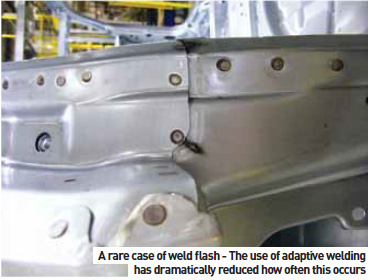 travel along the line. Wagner says the robotic movement could have interfered with these measurements if there was any vibration translated via the steel support structure, but he confidently reports there is not. “I took a wine glass - full of water - and placed it on the structure. We did an emergency stop and the water didn’t move! But we’re always checking this to make sure there is no vibration.”
travel along the line. Wagner says the robotic movement could have interfered with these measurements if there was any vibration translated via the steel support structure, but he confidently reports there is not. “I took a wine glass - full of water - and placed it on the structure. We did an emergency stop and the water didn’t move! But we’re always checking this to make sure there is no vibration.”
“In 2001 we had 51 robots in the bodyshop. Now, we have about 1,200,” says Wagner. He goes on to say that there was another big jump in terms of process automation between the previous M-Class and the new model. Now, 99% of all activities across the MBUSI bodyshop are completed automatically, with only a few exceptions. One of these is where a line worker adds sound-proofing and baffling pads to various chassis parts, although this is backed up by an automated quality control system. “To ensure the team member doesn’t miss any parts, we have installed a camerabased vision system.” As the person steps out of the cell, the system takes a photo of the work piece and compares that with a stored image of a ‘perfect’ part. If a difference is noted, the worker is alerted so they may re-enter the cell and fix the problem. He adds that similar vision systems are used to check each adhesive application across the BIW area.
Another new cell installed for production of the latest M-Class is a geometrical station for application of the various roof structures. Wagner: “There are three different parts, a glass roof, a sunroof and a standard roof. These are different for the M and GL, so there are six in total. The roof is first placed into a ‘nest’ or special racking, which is also new. Then the Kuka robot measures the roof opening using a series of camera sensors, before it grabs the roof and positions it in the optimum location.” The term ‘optimum’ is critical. As not every car is exactly the same due to minute deformations over the BIW process and the delivered roof assemblies can vary in size by just a few millimetres, optimum is the best fit based on comparing the two separate parts.
“The roof system uses the Euro-Gripper,” he continues. “It was a joint development by several European car manufacturers, including Mercedes. It’s manufactured by Tünkers. It was a big challenge to programme the cell, but it’s working now for the two models. We’re using it all over the world at Mercedes-Benz plants, but it’s new for this line.”
Weld types
According to Norbert Wagner, the MBUSI bodyshop currently employs two types of weld, resistance spot and TIG. Two formats of spot weld are used, respot and geospot. “For respot you don’t need any positional accuracy with regards to the palette or transport skid. The palette sits accurately, but not with high accuracy. In a geostation, [the palette] is positioned with very high accuracy, perhaps 3,000ths of an inch (8 microns), where the palette is clamped in order to accurately align the jig.” He adds that there are more than 100 geospots on each car.
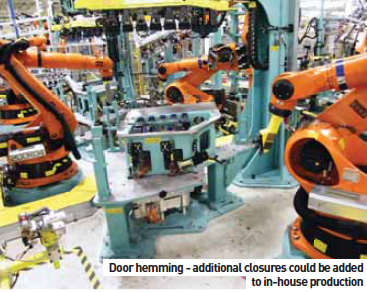 The technique for checking welds has also been updated, with chisel checks giving way to ultrasound testing. In addition to this, a new adaptive welding system has been installed across the updated areas of the bodyshop, which Wagner believes will help to reduce the need for weld testing. “If the sheet metal doesn’t have a perfect fit or the angle of the weld gun is not exactly aligned to the surface, it will flash. The flash is material being destroyed and you must grind off the dark spot - the weld might be great, but [the flash] could create a corrosion issue. Adaptive welding is a self-calibrating system; there is no flash, you don’t need to wear glasses anymore in the weld shop. We had a maximum target where 5% of the welds could have flash spots. [With the new system] we’re already at 1.4%, we’re really proud of that.”
The technique for checking welds has also been updated, with chisel checks giving way to ultrasound testing. In addition to this, a new adaptive welding system has been installed across the updated areas of the bodyshop, which Wagner believes will help to reduce the need for weld testing. “If the sheet metal doesn’t have a perfect fit or the angle of the weld gun is not exactly aligned to the surface, it will flash. The flash is material being destroyed and you must grind off the dark spot - the weld might be great, but [the flash] could create a corrosion issue. Adaptive welding is a self-calibrating system; there is no flash, you don’t need to wear glasses anymore in the weld shop. We had a maximum target where 5% of the welds could have flash spots. [With the new system] we’re already at 1.4%, we’re really proud of that.”
He further explains that while the original body line is still using standard welding, this is scheduled to be replaced by adaptive welding by mid-2012, making it the default welding method at MBUSI.
Planning for C-Class
Wagner says that there is currently no laser welding at the MBUSI bodyshop, although this will change with the addition of the fourth model to the production line up, the next-generation C-Class, which will also be built in Bremen, Germany, East London, South Africa, and at the Beijing Benz facility in China. Asked about how much of the process will be completed by laser-driven systems, the answer is a noncommittal “quite a lot”.
The addition of the C-Class will also mean more work being completed at the Tuscaloosa plant. “Right now, we produce the doors for the models built here,” says Wagner. “All the other closures, hood, liftgate and also the fenders, these are received from suppliers. For the C-Class we will probably change this. It’s about maintaining quality.”
Until then, only doors for the M-Class and GL-Class are produced in-house, a process which involves hemming the closures. “We put the outer door panel into the hemming bed and the inner is added. A ‘spider’ pushes the two parts together before a roller hemming head joins the two panels.” Continuing, Wagner explains that a special adhesive, which incorporates a glass medium to maintain panel spacing, is used to control corrosion. The product is applied using a controlled speed valve. “I never want to see a rusty Mercedes on the road. Twenty-five years ago, I had one, but not now. It’s another test of our quality.”
Tail light preparation
In order to prepare the liftgate and rear fenders for the application of rear lighting in the assembly hall, the two SUV models enter a dedicated cell which pierces holes for the related components. “We use what’s called a soft-touch, form and pierce process. The robots measure the opening with cameras and the gun forms and pierces the hole in the correct location.”
In much the same way as in the paintshop, a robot automatically raises the liftgate to allow the piercing to be performed. Only one robot is used to complete the process. “The robot with the gun has a clamp on one side, it measures and then completes the operation. It’s a case of true multi-tasking.”
Wagner goes on to explain why the piercings are not added in the stamping process. “You will always have some deformation over the complete BIW process, which means you will never have the left and right openings in the same position. You will have variances in X and Y, and that’s why we do it here. Half the tail light is in the liftgate, half in the body. Performing the procedure here allows you to match these identically. Even the gap between the two parts has to be taken into consideration.”
Body-in-white, says Wagner, has a lot to do with maintaining the premium quality of the Mercedes-Benz models produced in Tuscaloosa. “The overall cost of welding is driven by quality. What you pay is directly related to the level of quality demonstrated in the finished vehicles.”As such, it’s safe to say that a considerable portion of the latest investment package for MBUSI has been used to improve quality processes and efficiency across the bodyshop, but on inspection it appears to have been money well spent.

































